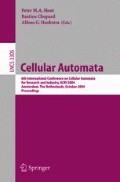Abstract
We present a dynamic, three-dimensional, composite model framework for vertebrate development. Our integrated model combines submodels that address length-scales from subcellular to tissues and organs in a unified framework. Interacting submodels include a discrete model derived from non-equilibrium statistical mechanics (Cellular Potts Model) and continuous reaction-diffusion models. A state diagram with associated rules and a set of ordinary differential equations model genetic regulation to define and control cell differentiation. We apply the model spatiotemporal bone patterning in the proximo-distal (from body towards digits) direction of developing avian limb.
Access this chapter
Tax calculation will be finalised at checkout
Purchases are for personal use only
Preview
Unable to display preview. Download preview PDF.
References
Chaturvedi, R., Izaguirre, J.A., Huang, C., Cickovski, T., Virtue, P., Thomas, G., Forgacs, G., Alber, M., Hentschel, G., Newman, S.A., Glazier, J.A.: In: Sloot, P.M.A., Abramson, D., Bogdanov, A.V., Gorbachev, Y.E., Dongarra, J., Zomaya, A.Y. (eds.) ICCS 2003. LNCS, vol. 2659, pp. 39–49. Springer, Heidelberg (2003)
Izaguirre, J.A., Chaturvedi, R., Huang, C., Cickovski, T., Coffland, J., Thomas, G., Forgacs, G., Alber, M., Hentschel, G., Newman, S.A., Glazier, J.A.: CompuCell, a multi-model framework for simulation of morphogenesis. Bioinformatics 20, 1129–1137 (2004)
Newman, S.A., Comper, W.D.: ’Generic’ physical mechanisms of morphogenesis and pattern formation. Development 110, 1–18 (1990)
Hentschel, H.G.E., Glimm, T., Glazier, J.A., Newman, S.A.: Dynamical mechanisms for skeletal pattern formation in the vertebrate limb. To appear in Proceedings R. Soc. Lond: Bio. Sciences (2004)
Murray, J.D.: Mathematical Biology, 2nd edn. Springer, Berlin (1993)
Miura, T., Shiota, K.: Tgf Beta2 acts as an activator molecule in reaction-diffusion model and is involved in cell sorting phenomenon in mouse limb micromass culture. Dev. Dyn. 217, 241–249 (2000)
Moftah, M.Z., Downie, S., Bronstein, N., Mezentseva, N., Pu, J., Maher, P., Newman, S.A.: Ectodermal FGFs induce perinodular inhibition of limb chondrogenesis in vitro and in vivo via FGF receptor 2. Dev. Biol. 249, 270–282 (2002)
Tsonis, P.A., Del Rio-Tsonis, K., Millan, J.L., Wheelock, M.J.: Expression of N-cadherin and alkaline phosphatase in the chick limb bud mesenchymal cells: Regulation by 1,25- dihydroxyvitamin D3 and TGF-betal. Exp. Cell Res. 213, 433–437 (1994)
Steinberg, M.S.: Reconstruction of tissues by dissociated cells. Science 141, 401–408 (1963)
Glazier, J.A., Graner, F.: A simulation of the differential adhesion driven rearrangement of biological cells. Phys. Rev. E 47, 2128–2154 (1993)
Upadhyaya, A.: Thermodynamic and fluid properties of cells, tissues and membranes, Ph.D. thesis, University of Notre Dame (2000)
Turing, A.M.: The chemical basis of morphogenesis. Phil. Trans. Roy. Soc. Lond. B 237, 37–72 (1952)
Alber, M., Glimm, T., Hentschel, H.G.E., Kazmierczak, B., Newman, S.A.: Stability of n-Dimensional Patterns in a Generalized Turing System: Implications for Biological Pattern Formation (2004) (submitted)
Zeng, W., Thomas, G.L., Newman, S.A., Glazier, J.A.: A Novel Mechanism for Mesenchymal Condensation during Limb Chondrogenesis in vitro. In: Capasso, V., Ortisi, M. (eds.) Mathematical Modeling and Computing in Biology and Medicine: 5th Conference of the European Society of Mathematical and Theoretical Biology, Milan (2002)
Kiskowski, M.A., Alber, M.S., Thomas, G.L., Glazier, J.A., Bronstein, N.B., Pu, J., Newman, S.A.: Interplay between activator-inhibitor coupling and cell-matrix adhesion in a cellular automaton model for chondrogenic patterning. Dev. Biol. 271, 372–387 (2004)
Cohen Jr., M.M., Kreiborg, S.: Hands and feet in the Apert syndrome. Am. J. Med. Genet. 57, 82–96 (1995)
Alber, M., Kazmierczak, B., Hentshcel, H.G.E., Newman, S.A.: Existence of solutions to a new model of avian limb formation (2004) (submitted)
Martin, G.R.: The roles of FGFs in the early development of vertebrate limbs. Genes. Dev. 12, 1571–1586 (1998)
Author information
Authors and Affiliations
Editor information
Editors and Affiliations
Rights and permissions
Copyright information
© 2004 Springer-Verlag Berlin Heidelberg
About this paper
Cite this paper
Chaturvedi, R., Huang, C., Izaguirre, J.A., Newman, S.A., Glazier, J.A., Alber, M. (2004). A Hybrid Discrete-Continuum Model for 3-D Skeletogenesis of the Vertebrate Limb. In: Sloot, P.M.A., Chopard, B., Hoekstra, A.G. (eds) Cellular Automata. ACRI 2004. Lecture Notes in Computer Science, vol 3305. Springer, Berlin, Heidelberg. https://doi.org/10.1007/978-3-540-30479-1_56
Download citation
DOI: https://doi.org/10.1007/978-3-540-30479-1_56
Publisher Name: Springer, Berlin, Heidelberg
Print ISBN: 978-3-540-23596-5
Online ISBN: 978-3-540-30479-1
eBook Packages: Springer Book Archive

